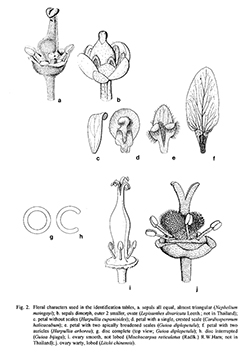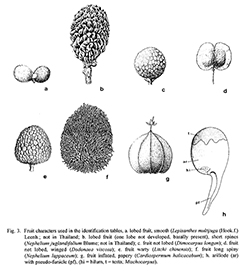e-Flora of Thailand
Volume 7 > Part 1 > Year 1999 > Page 189 > Sapindaceae > Cardiospermum
Cardiospermum halicacabum L.wfo-0000587875
Sp. Pl.: 366. 1753; Ridl., Fl. Malay Penins. 1: 488. 1922; Radlk. in Engl., Pflanzenr. 98: 379, f. 8a–c. 1932; Gagnep. in Fl. Gén. I.-C., Suppl. 1: 933. 1950; Leenh. in Fl. Males., Ser. 1, Spermat. 11: 484, fig. 12. 1994 (see also for complete synonymy). Fig. 2d, 3g. Fig. 9.
Accepted Name : This is currently accepted.
Description : Climber, often much branched, stems deeply 5-sulcate. Leaves 5–8 by 5–8 cm, sparsely appressed (sub)pilose. Leaflets ovate, symmetrical, herbaceous; base attenuate; apex and lobes acute, mucronulate; glabrous above, subpilose underneath; domatia absent. Inflorescences 5–14 cm long. Flowers 2–3.5 mm long, white. Sepals outer broadly ovate to suborbicular, 1–1.5 by ca 1.2 mm, inner suborbicular to broad-elliptic, 2–2.5 by 1.5–2 mm. Petals obovate-cuneate to orbicular, 1.5–2.5 by 1–2 mm; scales 1.2–2 by ca 1 mm, bearded; crest glabrous. Disc lobes glabrous. Stamens: filaments 0.8–2.5 mm long; anthers ca 0.5 mm long, yellow. Fruits 1.5–4 cm in diam., mostly sparsely short-hairy, green to tinged reddish; shortly stipitate. Seeds subglobular, ca 4 mm in diam., dull-black, smooth, glabrous; hilum white.
Thailand : NORTHERN: Tak (Doi Mu Soe), Nakhon Sawan (Khao Takli, Sombun Pond); NORTH-EASTERN: Nong Khai (Sri Chiang Mai); EASTERN: Ubon Ratchathani (Phibun Mangsahan); SOUTH-WESTERN: Kanchanaburi (Sangkhlaburi, Si Sawat, Wangka), Phetchaburi (Banpong), Prachuap Khiri Khan (Pran Buri); CENTRAL: Phra Nakhon Si Ayutthaya (Wat Pra Bat), Krung Thep Maha Nakhon (Bangkok); PENINSULAR: Chumphon, Surat Thani (Khao Tapet), Songkhla, Pattani (Nong Chik), Yala (Banangsta).
Distribution : Probably of American origin, but now a fairly common weed of the tropics and subtropics.
Ecology : In everwet as well as seasonal climate, on acid as well as basic soils, dry to marshy or even periodically flooded with fresh water, preferably in sunny places such as waste ground, road-sides, grasslands, scrubland, hedges in cultivated areas, also along forests edges and sometimes along sandy beaches, up to 1,500 m alt. The fruits are dispersed by sea, rivers, over short distances by the wind, but mainly by man. Flowering and fruiting: whole year, in Thai specimens: July, November, December.
Vernacular : Luplip khruea (ลูบลีบเครือ)(Northern); ka khom (กะคอม)(Central); khok kra om (โคกกระออม)(Central, Peninsular); wiwi (วิวี)(Southeastern); pho om (โพออม)(Peninsular).





